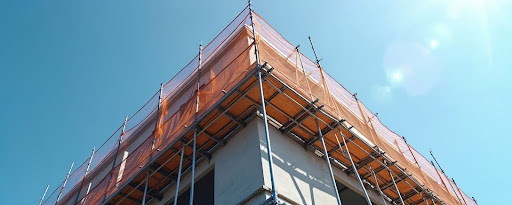What is the Australian Standard for Scaffolding?
The main standard for scaffolding in Australia is AS/NZS 1576. It sets out mandatory requirements for all scaffolding structures on construction sites. This standard covers everything from how scaffolds are designed to how they are taken down.
Following the Australian scaffolding standards is important for keeping workers safe and following the law. If construction companies don’t comply, they could face heavy fines, work stoppages, and increased liability.
The standards cover important aspects such as:
- Design specifications for structural integrity
- Installation procedures for safe assembly
- Material quality requirements for components
- Inspection protocols for ongoing safety
Specific performance criteria outlined in these regulations must be met by scaffold mesh and temporary scaffolding components. While providing essential debris containment and fall protection, scaffolding mesh integrates seamlessly with standard scaffold systems to ensure compliance with Australian regulations for modern construction projects.
What is the 4 to 1 Scaffolding Rule?
The 4 to 1 rule establishes that scaffold height cannot exceed four times the base width. A scaffold with a 2-metre base width can safely reach 8 metres in height under standard conditions.
This scaffold base width to height ratio prevents structural instability by maintaining the centre of gravity within safe parameters. The ratio distributes loads evenly across the base, reducing stress concentration points that could cause collapse.
Scaffold stability guidelines require consideration of several factors:
- Scaffolding system type – tube and fitting systems may require different ratios than prefabricated systems
- Environmental conditions – wind loads and ground conditions affect stability requirements
- Load requirements – heavy materials or equipment may necessitate wider bases
- Site mesh and chain & shade mesh installations add wind loading that impacts the ratio calculation
Ground conditions play a crucial role in applying the 4 to 1 rule. Soft or uneven surfaces may require base plates or mudsills to distribute loads effectively, potentially affecting the practical base width measurement.
What Must Be Installed on Every Scaffold?
Australian regulations mandate specific scaffold safety features on every structure to protect workers and comply with AS/NZS 1576 standards.
Essential mandatory components include:
- Guardrails – minimum 900mm height on all open sides
- Mid-rails – positioned between guardrails and toe boards
- Toe boards – minimum 150mm height to prevent material fall
- Safe access points – ladders or stairways with proper handholds
Scaffold mesh installation serves dual purposes beyond basic safety requirements. Scaffold netting prevents tools and debris from falling to ground level, protecting pedestrians and property below. The mesh creates a contained work environment that reduces liability risks.
Scaffold shade cloth provides crucial worker protection equipment against harsh Australian UV exposure. Chain and shade mesh options offer 50% or 90% coverage, allowing sites to balance sun protection with ventilation needs. Urban construction projects benefit from noise reduction properties of dense mesh installations.
The combination of mandatory structural elements with protective mesh systems creates comprehensive safety barriers that exceed minimum regulatory requirements whilst addressing site-specific environmental challenges.
Which Scaffold is Prohibited?
Prohibited scaffolds include any structure that violates the 4 to 1 base-to-height ratio or fails to meet AS/NZS 1576 standards. Excessively tall scaffolds with narrow bases create immediate tipping hazards, whilst incomplete structures lacking proper bracing represent serious unsafe scaffolding practices.
Non-compliant scaffold types that Australian regulations specifically ban include:
- Scaffolds exceeding height limits without adequate base width
- Structures missing essential components like guardrails or toe boards
- Makeshift platforms using unsuitable materials
- Scaffolds without proper scaffold mesh protection where falling debris poses risks
Using prohibited scaffolding configurations exposes workers to severe injury risks including falls, structural collapse, and falling object strikes. Legal consequences include prosecution under Work Health and Safety laws, substantial fines reaching hundreds of thousands of dollars, and potential imprisonment for serious breaches.
Construction companies face additional liability through insurance claim rejections, project delays, and reputation damage. Regulatory authorities can issue immediate stop-work orders, forcing costly project shutdowns until compliant scaffolding replaces dangerous structures.
How Often Should Scaffolds Be Inspected?
Australian construction regulations mandate daily scaffolding mesh inspections before work begins. Additional inspections are necessary after significant weather events, structural modifications, or incidents that may compromise stability.
Essential Inspection Checklist
- Structural integrity: Check formwork plywood and LVL beams for damage or deterioration
- 4:1 ratio compliance: Verify base-to-height measurements remain within acceptable limits
- Site mesh maintenance: Inspect scaffold mesh and chain & shade mesh for tears, loose connections, or UV damage
- Load capacity: Ensure materials and equipment don’t exceed design limits
- Access points: Confirm ladders, platforms, and guardrails are secure
Construction site safety audits should document all findings and corrective actions. Competent persons must conduct these inspections, with records maintained throughout the project duration. Any defects identified require immediate rectification before work resumes.

